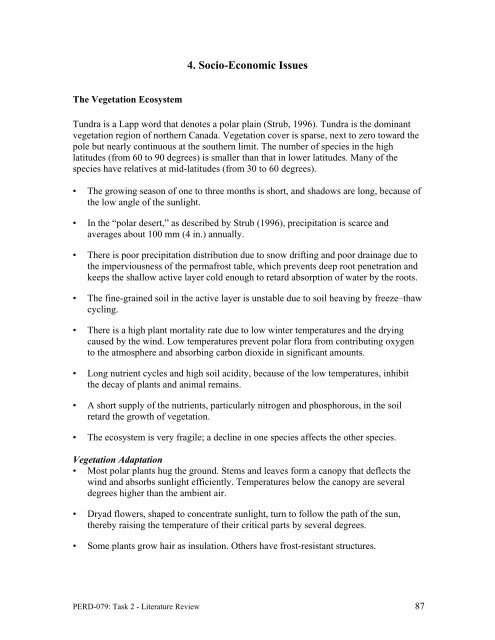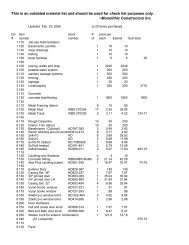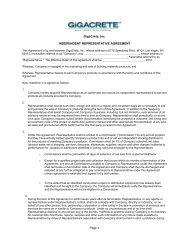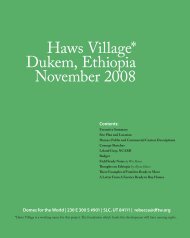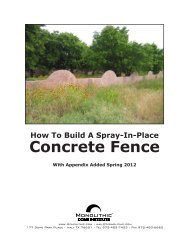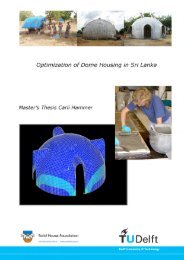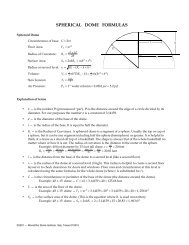Literature Review on Building Envelope, Heating and ... - Beeshive.org
Literature Review on Building Envelope, Heating and ... - Beeshive.org
Literature Review on Building Envelope, Heating and ... - Beeshive.org
Create successful ePaper yourself
Turn your PDF publications into a flip-book with our unique Google optimized e-Paper software.
4. Socio-Ec<strong>on</strong>omic Issues<br />
The Vegetati<strong>on</strong> Ecosystem<br />
Tundra is a Lapp word that denotes a polar plain (Strub, 1996). Tundra is the dominant<br />
vegetati<strong>on</strong> regi<strong>on</strong> of northern Canada. Vegetati<strong>on</strong> cover is sparse, next to zero toward the<br />
pole but nearly c<strong>on</strong>tinuous at the southern limit. The number of species in the high<br />
latitudes (from 60 to 90 degrees) is smaller than that in lower latitudes. Many of the<br />
species have relatives at mid-latitudes (from 30 to 60 degrees).<br />
• The growing seas<strong>on</strong> of <strong>on</strong>e to three m<strong>on</strong>ths is short, <strong>and</strong> shadows are l<strong>on</strong>g, because of<br />
the low angle of the sunlight.<br />
• In the “polar desert,” as described by Strub (1996), precipitati<strong>on</strong> is scarce <strong>and</strong><br />
averages about 100 mm (4 in.) annually.<br />
• There is poor precipitati<strong>on</strong> distributi<strong>on</strong> due to snow drifting <strong>and</strong> poor drainage due to<br />
the imperviousness of the permafrost table, which prevents deep root penetrati<strong>on</strong> <strong>and</strong><br />
keeps the shallow active layer cold enough to retard absorpti<strong>on</strong> of water by the roots.<br />
• The fine-grained soil in the active layer is unstable due to soil heaving by freeze–thaw<br />
cycling.<br />
• There is a high plant mortality rate due to low winter temperatures <strong>and</strong> the drying<br />
caused by the wind. Low temperatures prevent polar flora from c<strong>on</strong>tributing oxygen<br />
to the atmosphere <strong>and</strong> absorbing carb<strong>on</strong> dioxide in significant amounts.<br />
• L<strong>on</strong>g nutrient cycles <strong>and</strong> high soil acidity, because of the low temperatures, inhibit<br />
the decay of plants <strong>and</strong> animal remains.<br />
• A short supply of the nutrients, particularly nitrogen <strong>and</strong> phosphorous, in the soil<br />
retard the growth of vegetati<strong>on</strong>.<br />
• The ecosystem is very fragile; a decline in <strong>on</strong>e species affects the other species.<br />
Vegetati<strong>on</strong> Adaptati<strong>on</strong><br />
• Most polar plants hug the ground. Stems <strong>and</strong> leaves form a canopy that deflects the<br />
wind <strong>and</strong> absorbs sunlight efficiently. Temperatures below the canopy are several<br />
degrees higher than the ambient air.<br />
• Dryad flowers, shaped to c<strong>on</strong>centrate sunlight, turn to follow the path of the sun,<br />
thereby raising the temperature of their critical parts by several degrees.<br />
• Some plants grow hair as insulati<strong>on</strong>. Others have frost-resistant structures.<br />
PERD-079: Task 2 - <str<strong>on</strong>g>Literature</str<strong>on</strong>g> <str<strong>on</strong>g>Review</str<strong>on</strong>g> 87


